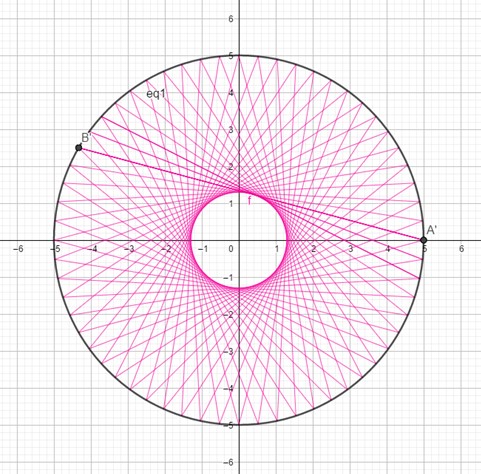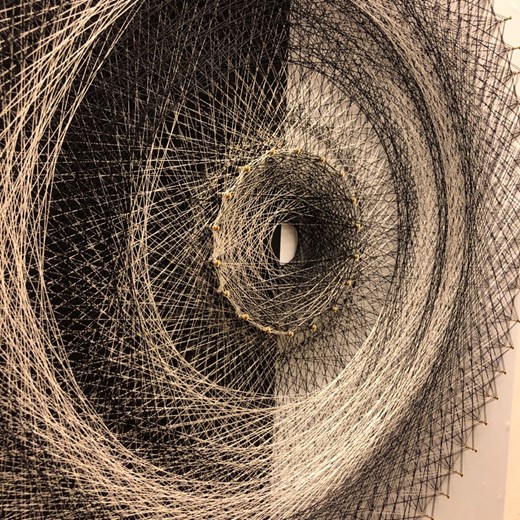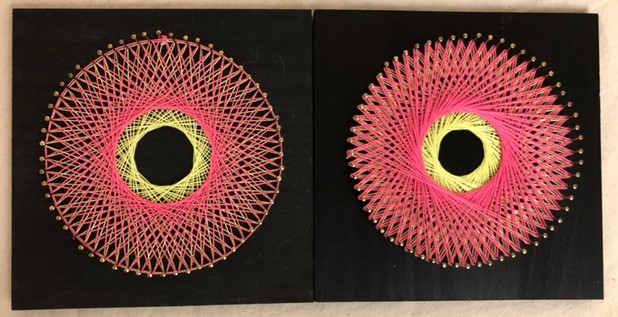Geometry Stringart Class Day 3 - Geogebra Simulation vs Real String Art
3. Geogebra Simulation vs Real String Art
GeoGebra can calculate and predict geometric patterns, but it is not easy to perfectly simulate real string art.
This is because, unlike simulations, in actual string art, there are (1) the direction in which the threads are weaved around the nail and (2) the order in which the threads are stacked from the bottom to the top of the nail. Let's go through them one by one below.
1. Directionality
Even we can calculate and predict the geometry pattern with Geogebra, it is not easy to simulate REAL STRING ART perfectly. Because in the actual string art, directionality occurs around the nail.
In other words, there is only one line segment generated between 2 points based on the theory of mathematics as below.
[Only one line segment in String Art Simulation]
However, in real string art, we have two choices – the one is weaving thread from left to right and the other is weaving thread from right to left.
There are two cases to be compared.
- Below Left Case
We move the threaded nail ‘clockwise’ and weave the thread around nail ‘clockwise’.
- Below Right Case
We move the threaded nail ‘clockwise’ and weave the thread around nail ‘counterclockwise’. There is a twisted shape around the nail as picture.
Because of these two choices, it is difficult to express the exact same geometry pattern simulated in Geogebra in Real String Art. However, if you keep consistency, you can make symmetrical and not skewed geometry. Direction to move threaded nail and direction to weave around nail need to be same and this rule should be kept.
Also, we can use twisted shape intentionally to give a pattern a three-dimensional effect. When we can use both cases according to our needs, we can make beautiful geometry patterns.
[Created pattern & gradation based on principle]
2. The Order of Thread Stacked
There is one more factor that might make us confused. When I start string art, I was really confused because of it.
Can you recognize the difference between following two pictures?
[Two same patterns with different density and uniformity]
We can see that the threads are evenly distributed and symmetric in above left picture. And the density of threads is low.
However, in above right picture, we can see that the thread at the end point is stacked on the thread at the start point. Also, the density of threads is high.
What this difference comes from?
They describe exact same pattern simulated in same way in Geogebra.
In actual, the difference comes from ‘the order which threads are stacked’. In real string art, the first woven thread will be on the bottom of the nails. As we continue to weave the threads around the nails, the threads gradually build up to the top of the nail. So, there is the ‘ORDER’ of threads stacked in real string art.
Following two ways are different two ways to describe same pattern. It is easy to weave like right side because the rule to weave is simple. (Also, it is easy to make gradation. For details, I would explain in Part.2)
The left one, we need to care about the ‘the quantity of nails’ (it means angle to rotate) to skip for next weaving. It may be more difficult, but we can make ‘uniformity’.
[Two ways weave threads for same pattern]
So, which method will be superior? To tell the truth, nothing can be described as superior.
We can choose right method to express the pattern and shape that we want well. So, it would be great to understand both way and to get used to them.
[A string Art that two methods are mixed freely]
So far we have briefly looked at the theories involved.
Now, let’s go into practice and experience Geogebra and Stringart.








Comments
Post a Comment